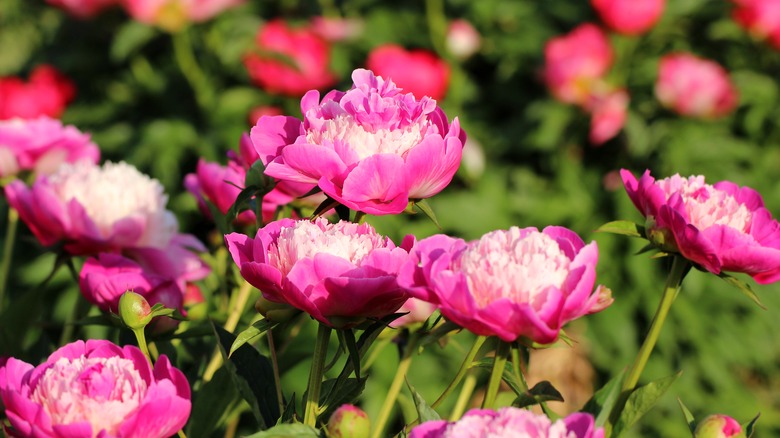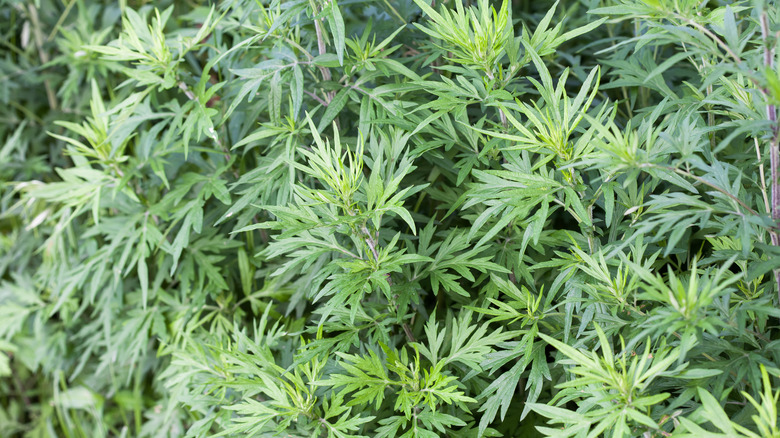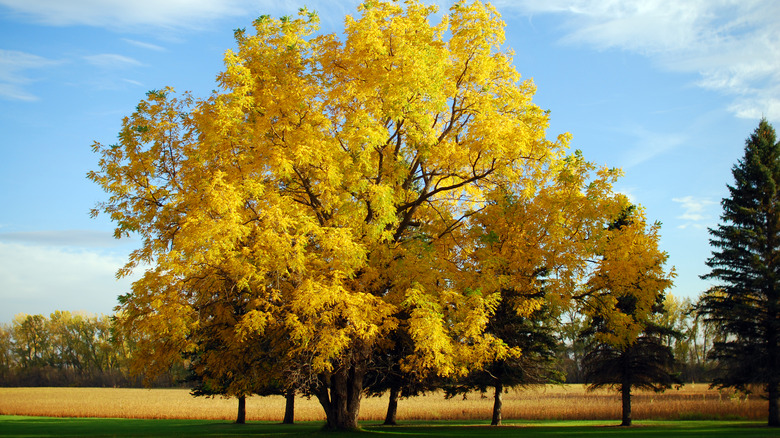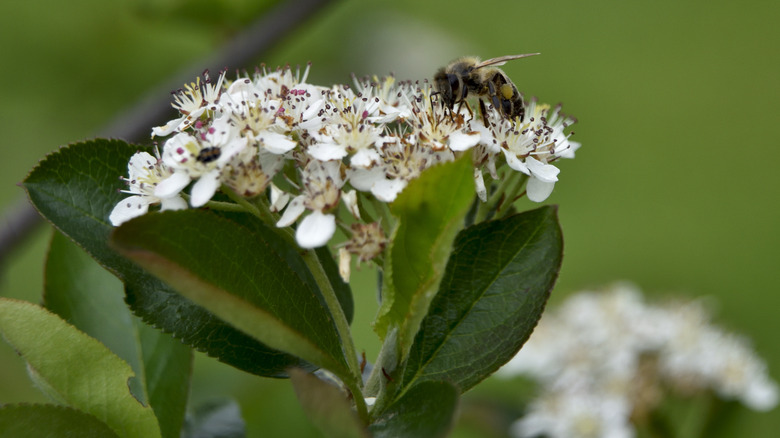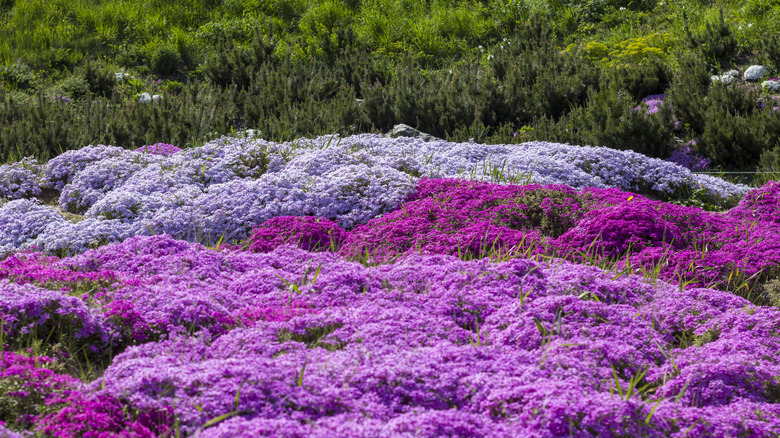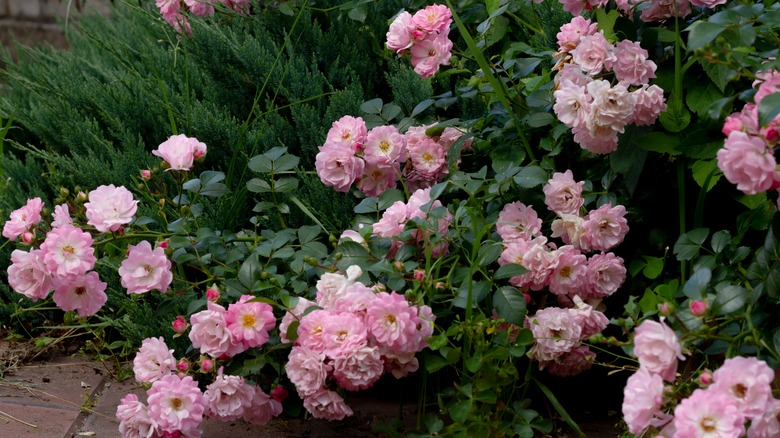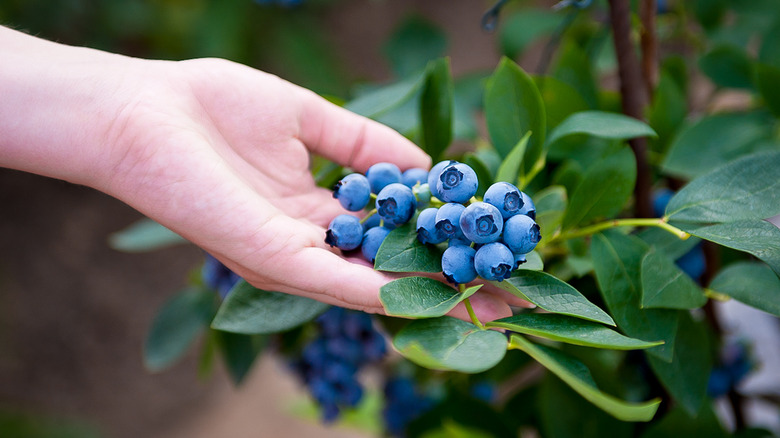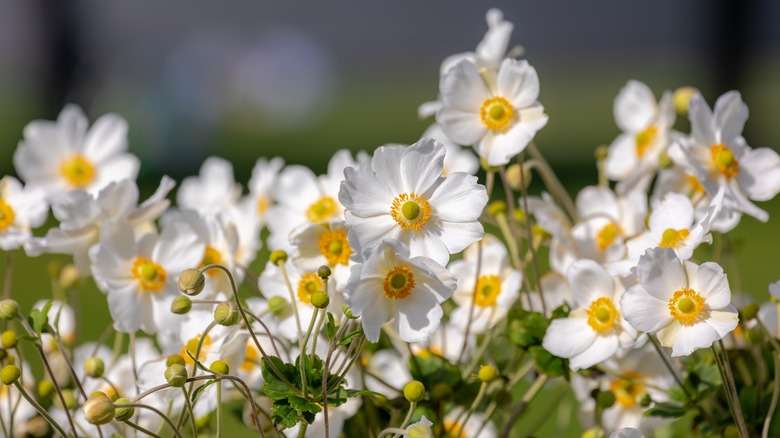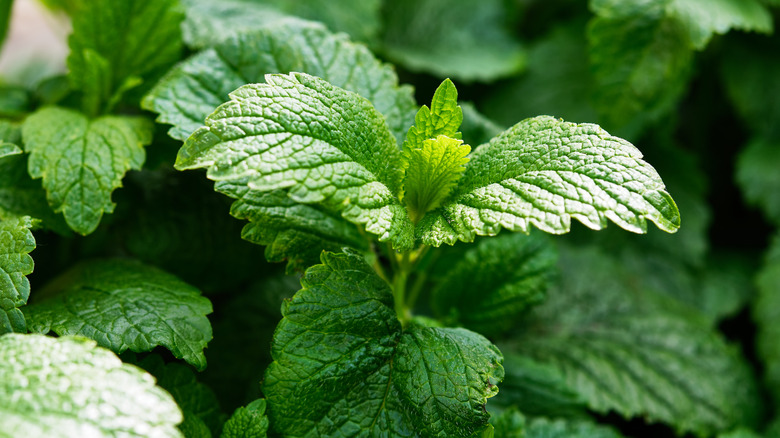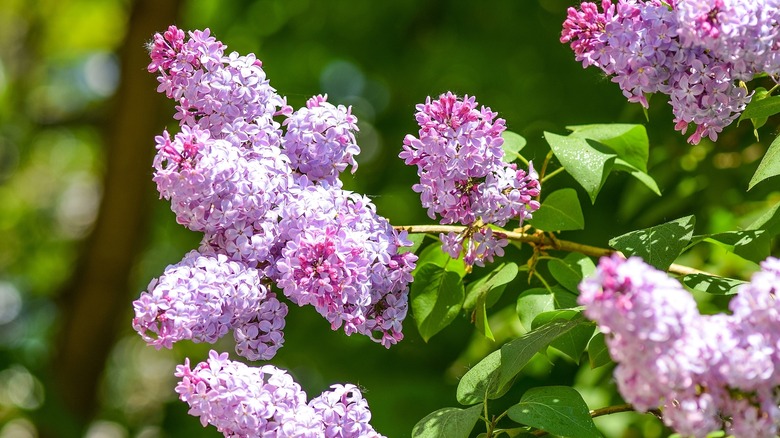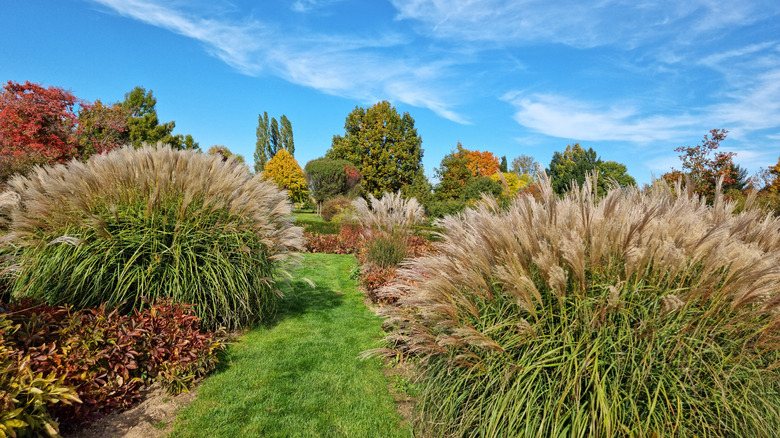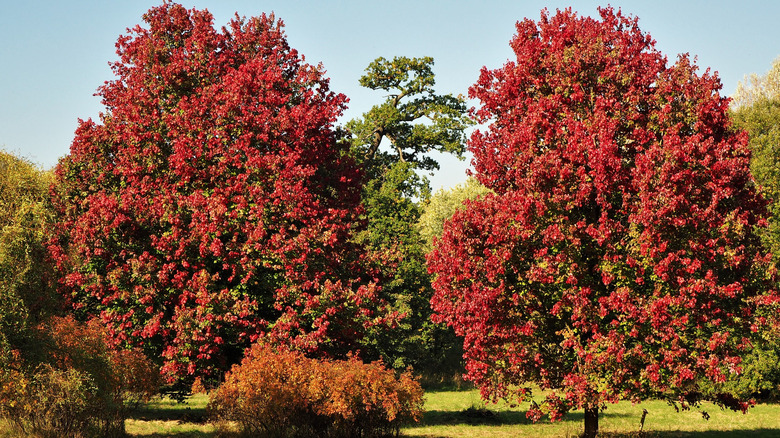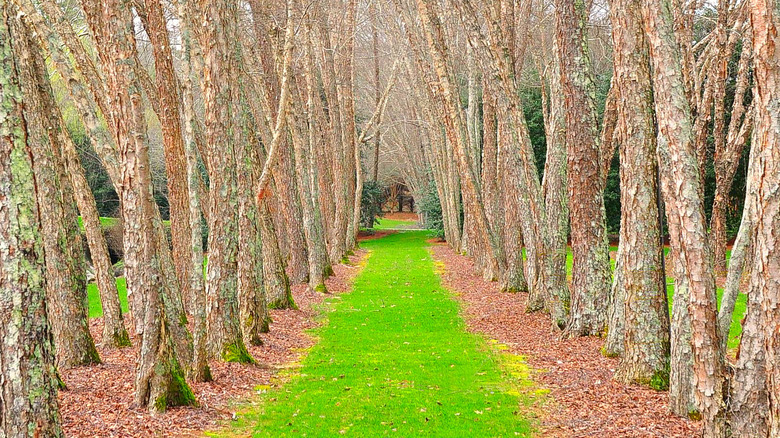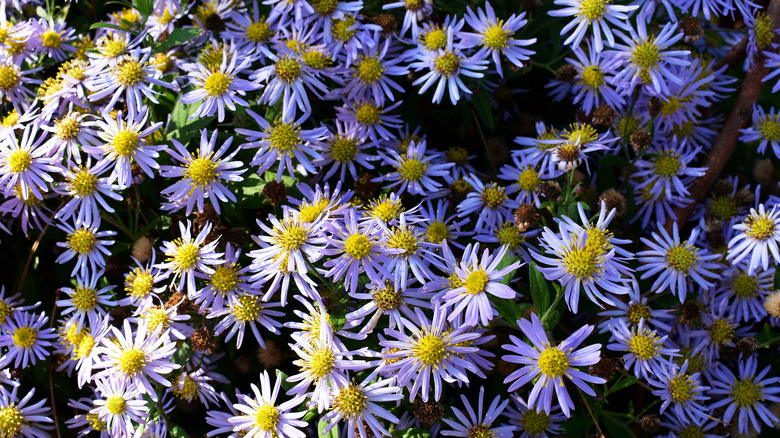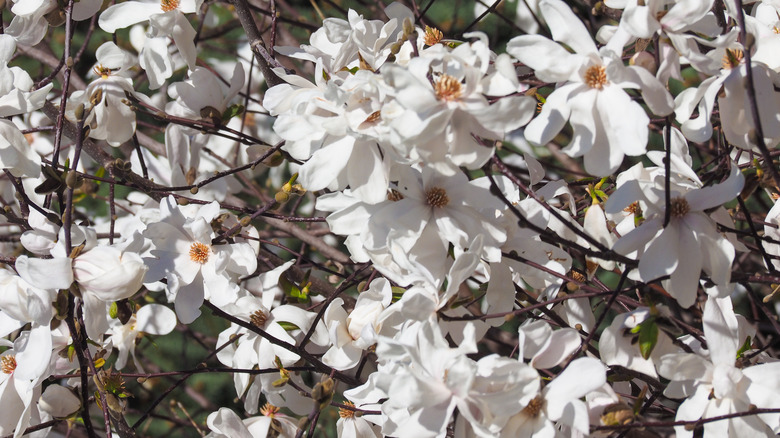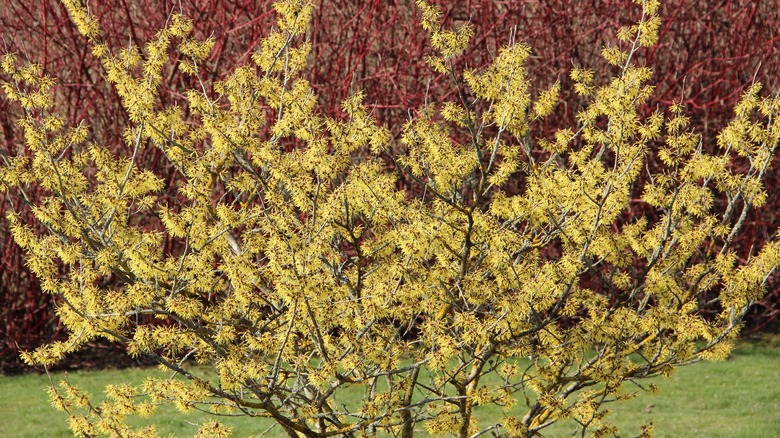15 Peony Companion Plants You Should Avoid In The Garden
Peonies are gorgeous flowers. Their many layers of feather-soft petals are delicate and unique, attracting many fans. They're not particularly difficult to grow, although being far less ubiquitous than roses or tulips can certainly make it seem as if they are. Their bloom time lasts approximately two months through April and June. One key to seeing those spectacular blooms and successfully grow peonies is to avoid planting them next to companion plants that will hamper their growth. Nutrient-hogging plants and overspreaders are some of the biggest offenders, with sunshine-stealing tall trees and hedges also causing problems. We've compiled a list of 15 plants to avoid cultivating next to your peonies to keep those delicate blooms flourishing.
Peonies should be planted in the fall so they can blossom come springtime. They require a minimum of six hours of full sun each day and should be planted in a shallow plot dug into moist, well-draining soil so the top of the root is at the surface. Companion plants will require similar conditions, but can't be placed too closely or the peonies might succumb to disease or suffocation. But even in the right conditions, the wrong companion plants can impede your efforts, so make sure not to plant peonies too close to artemisia, chokeberry, highbush blueberries, and more.
Don't spread the Artemisia
Artemisia is a genus of plant comprised of wormwood, mugwort, sagebrush, and tarragon varieties, many of which have silvery leaves that make them favorite additions to moon gardens. Artemisia species also boast fragrant aromas that theoretically would mix well with peonies' sweet smell. Unfortunately, Artemisia spreads its roots underground mostly in long-reaching rhizomes, crowding out its neighbors. A particular type of mugwort is especially problematic, aggressively propagating across your yard. Artemisia vulgaris mugwort (the common variety of the herb), while attractive and aromatic, will cause your peonies to wither and reduce its blossoms significantly.
Peonies have toxic relationships with black walnut trees
Juglone is an organic compound sometimes used as an herbicide that naturally occurs in black walnut trees. A sort of evolutionary defense mechanism, it inhibits the growth of certain plants in its vicinity so the walnut thrives. Peonies, among other herbaceous perennials, are sensitive to juglone, and will show numerous signs of illness if planted anywhere within 60 feet of a black walnut trunk. This doesn't mean you can't have a black walnut tree in your yard; there are many types of plants that are juglone-tolerant. Just keep your peonies far away.
Chokeberry's gonna choke
The chokeberry shrub has gained popularity as renewed interest in homeopathic medicine and natural remedies has sparked. It's a robust shrub that is tolerant of virtually any type of soil, from sandy to swampy, and requires little maintenance, so there's a definite appeal to planting it in your yard. However, its fibrous roots and suckers tend to spread out rapidly, forming colonies. These thickets, as the name suggests, choke out other florals, peonies among them. As if the threat of suffocation weren't enough, chokeberries also attract deer and rabbits, which sometimes nibble at young peony plants.
Creeping phlox spreads far and wide
The descriptor for creeping phlox is something of a misnomer, because the evergreen does more than just creep across your yard. Creeping phlox forms a veritable carpet of flowers as it grows, spreading to as wide as 2 feet from a single plant. As with other aggressive spreading plants, peonies do not consider creeping phlox good neighbors. Peonies require space to breathe, and while the phlox do not grow tall and would allow a peony to tower overhead, they will inevitably overtax the roots in their claim for nutrients. Keep the two separate.
Don't mistakenly buy groundcover roses
Roses are often listed as an ideal perennial to grow alongside your peonies, but groundcover roses are another story entirely. Available in multiple cultivars, groundcover roses grow exactly as their name suggests, spreading out along the ground and covering a lot of terrain as they do. These are compact shrubs that might appeal to those who have small yards or dislike taller bushes. Indeed, groundcover roses are wonderfully resilient, beautiful additions to containers, borders, hillsides, or raised beds, but their natural tendency to invade others' spaces makes them an antagonist to peonies.
Highbush blueberries bring all the moths to your yard
Who doesn't love fresh-picked berries, straight from the garden? Blueberries are high in antioxidants and iron, and the highbush blueberry is the dominant variety you see available for purchase. Unfortunately, it seems the answer is that nobody doesn't like them, as migrating birds and mammals thrive on them, as do over 200 species of butterflies and moths. These are lovely pollinators and make for a pretty backyard display, but plant them too close to your peonies and the moth larvae will likely make a meal of the delicate flower's roots.
Japanese anemone make their own meadows
While sometimes called windflowers, Japanese anemones actually can give the appearance of wildflowers, as, once established, they spread rapidly and with abandon via underground rhizomes. In fact, as long as their soil remains moist and well-draining, they will spread faster and faster the more sun they manage to soak in each day. If left untended, you'll soon have a small meadow on your hands that will be difficult to eradicate. That's simply too much for peonies. They can't compete with the anemones' nutrient-hogging ways and will quickly decline if encroached upon by them.
Lemon balm is not a balm to peonies
Adding herbs to your flower and border gardens adds a lot of visual interest in addition to their tempting scents. Lemon balm is one such herb that brings the smell of citrus into the mix. A member of the mint family, it can be added to teas, salads, and other savory dishes. It's even resistant to deer and insect pests. But its fast-growing and spreading tendencies make it a menace as far as peonies are concerned, and the two should therefore not be planted in conjunction with one another.
Lilacs are overly competitive
Lilacs are renowned for their lovely blooms and signature scent. Don't be fooled by their delicate blossoms, though; these little flowers are a competitive bunch. Their roots will sucker and spread if not kept in check, forming colonies. Some sources will list lilacs as good companion plants for peonies because they both thrive in similar conditions, but this is actually what makes them poorly matched, as the lilac's dominance will leave little left for the peonies. Even if you're diligent about controlling your lilac's spread, its eventual shade cover can rob the peonies of needed sunlight. If you insist on this plant combination, consider dwarf Korean lilacs, which are smaller and more well-behaved than common lilac.
Ornamental grasses make good rabbit nests
If you're looking to attract bunnies to your garden, try letting things grow a little wild so the area resembles a more natural habitat. Growing ornamental grasses is an effective way of doing this that doesn't detract from the beauty and order of your landscaping. Rabbits will find the tall grasses comforting and consider them a safe space to nest and rest. However, bunnies have been known to eat young peony shoots. While rabbits sometimes nest in the open, better to not give them a convenient hiding spot if peonies are your priority.
Red maples throw shade
If you're looking for a solid and dependable shade tree with stunning fall foliage, the red maple (acer rubrum) checks all the boxes. Plant it far away from any peony beds you might have, though, because the red maple grows quickly and its canopy can eventually grow to a reach of 35 feet in diameter. Peonies need at least 6 hours of sun each day. In the hotter climes of zones 8 and 9, indirect sunlight is likely sufficient (or even preferable, depending on the heat index), but shade will see your peonies quickly decline.
Keep clear of river birches
A popular shade tree is the river birch, which thrives in moist soil and full sun. Along with a symmetrical branching pattern, its two-toned leaves, damage-resistant branches, and distinct bark make it a favorite among landscapers. Of course, with a canopy that spreads as wide as 40 feet, sun-loving peonies should not be planted nearby, but there's another reason to keep peonies away. River birches host around 300 species of lepidoptera, and are a popular larval spot for some. Larvae will devour your peonies if given the chance, so do your best to discourage them.
Smooth aster is a super attractor
The smooth aster is a contender for anyone intending to start a pollinator garden. They're hardy and reliable, with tall, sturdy stalks and attractive petals that catch the interest of all manner of wildlife, particularly bees and butterflies. In addition, it blooms late in the season, extending garden activity. All that wildlife may damage other plants though, including peonies. Typically peonies aren't targeted by many pests, but in close proximity hungry animals are opportunistic, particularly rabbits, who like the aster's tall stems, and pearl crescent butterflies, whose larvae hatch on the aster's leaves.
Sweetbay magnolias are growers
People love magnolia trees, not just for their beauty and fragrance, but because they are relatively compact, as trees go, and therefore can fit into various areas of a landscaping plan. And if they have moist soil and 4-6 hours of sunlight daily, they'll grow and produce lovely blooms with regularity. In fact, they'll actually grow quicker than most people anticipate, getting up to 20 feet wide. So by all means, plant them in your yard, but make sure you plant anything that requires full sun at least half that distance from the trunk, peonies included.
White oak trees are problematic
Unless you have acres and acres, a white oak doesn't really belong anywhere in your yard, much less next to peonies. It's a veritable giant that can spread its branches across a diameter of 80 feet or more, transforming a lawn from sunny to shady. Nothing that needs significant sunlight to grow can be planted within its reach. Moreover, the root system of the white oak spreads out laterally once the main taproot has been established, uprooting other plants and even structures in their path. The delicate peony doesn't stand a chance.
Witch hazel is a host plant
With many homeopathic medicinal uses and its being an ideal candidate for inclusion in winter gardens, growing witch hazel isn't a bad idea. Unless, that is, you hope to plant a witch hazel shrub next to peonies. If the roots of the witch hazel are planted too deeply, they may sucker and spread. Most notably, though, is that witch hazel is the larval host for dozens of different moth species. If given the opportunity, these larvae will feed on the crown and roots of peonies, destroying the plants.
